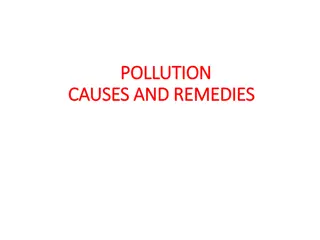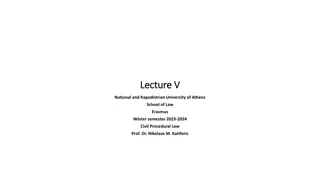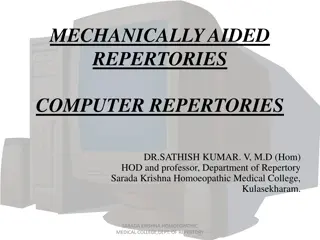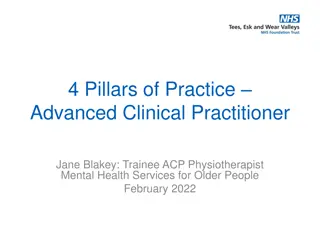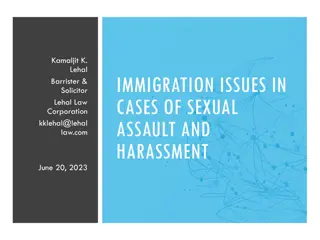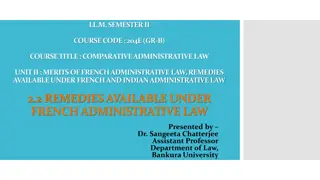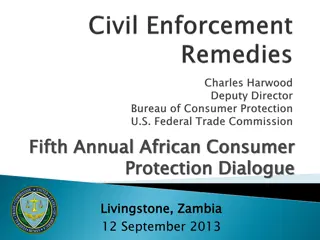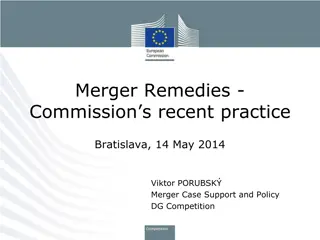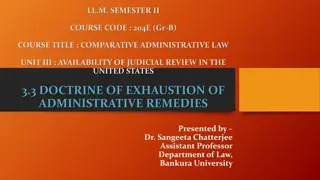Remedies Update in Practice and Procedure
Key principles of the common law discretion and the reach of section 31(2A) in the context of remedies update. Discover insights on conduct, burden of proof, and the role of evidence in judicial review. Delve into the nuances of decision-making processes and the standard of proof required for relief. Gain a comprehensive understanding of the factors determining substantial difference in legal decisions.
Download Presentation

Please find below an Image/Link to download the presentation.
The content on the website is provided AS IS for your information and personal use only. It may not be sold, licensed, or shared on other websites without obtaining consent from the author.If you encounter any issues during the download, it is possible that the publisher has removed the file from their server.
You are allowed to download the files provided on this website for personal or commercial use, subject to the condition that they are used lawfully. All files are the property of their respective owners.
The content on the website is provided AS IS for your information and personal use only. It may not be sold, licensed, or shared on other websites without obtaining consent from the author.
E N D
Presentation Transcript
ALBA SUMMER CONFERENCE 2021 Practice and procedure: remedies an update Sarah Hannett QC 13 July 2021 matrix@matrixlaw.co.uk +44 (0)20 7404 3447
NO SUBSTANTIAL DIFFERENCE: INTRODUCTION The common law discretion: Where the result would inevitably have been the same so that the flaw in the decision was immaterial: e.g. Simplex [1988] 3 PLR 25, 42 Section 31(2A) Senior Courts Act 1981 Relief must be refused if it appears to the court to be highly likely that the outcome for the applicant would not have been substantially different if the conduct complained of had not occurred : subsection (2A) Requirement may be disregarded if the court certifies that it is appropriate to do so for reasons of exceptional public interest : subsections (2B), (2C) Common law vs section 31(2A): Plan B Earth [2020] PTSR 1446, 272 No discretion (subject to the exceptional public interest discretion) Outcome does not inevitably have to be the same; highly likely suffices Outcome does not have to be exactly the same; it will suffice that it is highly likely that the outcome would not have been substantially different matrix@matrixlaw.co.uk +44 (0)20 7404 3447
NO SUBSTANTIAL DIFFERENCE: KEY PRINCIPLES (1) Reach of section 31(2A): Subsection (8) defines conduct as the conduct (or alleged conduct) of the defendant that the applicant claims justifies the High Court in granting relief . Not restricted to procedural or technical errors: Goring-on-Thames [2018] 1 WLR 5161, 47, a surprising concept ; concept of conduct in section 31(2A) is a broad one, and apt to include both the making of substantive decisions and the procedural steps taken in the course of decision-making Applies to judicial review, not to statutory appeals Not applicable to interim relief: NN [2019] EWHC 1003 (Admin), 19 The role of evidence: (Broadly) judicial scepticism about post-hoc witness statements: self-interested speculations of this kind should be approached with scepticism by a court PSCU [2018] ICR 269, 91 Cf Harvey [2017] EWCA Civ 1784, 47: court would evaluate ex post facto evidence carefully but it is nonetheless telling that none of the decision-makers in the case have felt able to put before the court any witness statements to support the contention . Post-decision EIAs in PSED claims more likely to be given weight matrix@matrixlaw.co.uk +44 (0)20 7404 3447
NO SUBSTANTIAL DIFFERENCE: KEY PRINCIPLES (2) Dawson [2021] EWHC 928 (Admin) per Linden J at 149: Burden of proof is on the defendant: Bokrosova [2016] PTSR 355, 99 Standard of proof the hurdle remains a high one: PCSU, 89 The court is required to address, on the evidence, the hypothetical or counterfactual question whether it is highly likely that the outcome would have been substantially the same had the conduct not occurred: PCSU, 89 That necessarily involves undertaking its own assessment of the decision making process: Goring-on-Thames 47 But the court should proceed with caution given the high standard of probability and the hypothetical nature of the inquiry, and it should be careful not to trespass into the domain of the decision maker: KE [2018] EWHC 2103, 140 matrix@matrixlaw.co.uk +44 (0)20 7404 3447
THEMES (1) Tension between the statutory purpose of section 31(2A) and the doctrine of the separation of powers: Gathercole [2021] PTSR 359, 38: It is important that a court faced with an application for judicial review does not shirk the obligation imposed by s 31(2A) The provision is designed to ensure that the judicial review process remains flexible and realistic. cf Plan B, 273: the court should still bear in mind that Parliament has not altered the fundamental relationship between the courts and the executive. In particular, courts should still be cautious about straying, even subconsciously, into the forbidden territory of assessing the merits of a public decision under challenge Courts should also not lose sight of their fundamental function, which is to maintain the rule of law . The nature of the unlawfulness: PSED: Aldwyck Housing Group [2019] EWCA Civ 1334, 21-24: I would decline to accept the proposition that, as a general rule, if there is a breach of the PSED, any decision taken after such breach must necessarily be quashed or set aside or even the proposition that there is only a narrow category of cases in which that consequence will not follow . Rejected the submission that discretion to refuse relief in PSED cases limited to those in which there was either (i) subsequent compliance with the PSED, or (ii) convincing undertaking that the duty will be complied with in the future, 26-31 matrix@matrixlaw.co.uk +44 (0)20 7404 3447
THEMES (2) Failure to consult/flaws in consultation: Shaw [2020] EWHC 2216 (Admin), 116; Law Society [2018] EWHC 2094 (Admin), 141; Dawson, 150 Rationality: CC of the West Midlands [2020] EWHC 1400 (Admin), 63 Type of decision/nature of decision maker? Aldwyck Housing Group, 22-24: distinction drawn between failure to comply with the PSED in major government decisions affecting numerous people (as in Hurley and Bracking) and a decision affecting an individual tenant of a social or local authority landlord , 116 Grinham [2020] EWHC 2140 (Admin), 72: classic case of the need for justice not only to be done but to be seen to be done More than one error of law or overlapping/interleaving reasons for a decision: Havant Biogas Ltd [2021] EWHC 84 (Admin) 91, Given the way that themes recur and interrelate within the Operative Decision, and the need to read it as a whole, it is unlikely that any strand would have been insulated from error elsewhere Quashing order is not a disciplinary measure : West Berkshire DC [2016] 1 WLR 3923, 87 I would resist the notion that the court should act as some sort of mentor or nanny to decision-makers : Aldwyck Housing Group at 25 matrix@matrixlaw.co.uk +44 (0)20 7404 3447
CERTIFIED EXCEPTIONAL PUBLIC INTEREST Even where section 31(2A) applies, the court may disregard it if it considers that it is appropriate to do so for reasons of exceptional public interest : subsection (2B); the court must certify this test is met: subsection (2C) Plan B, 277: The legal issues are of the highest importance. The infrastructure project under consideration is one of the largest. Both the development itself and its effects will last well into the second half of this century. The issue of climate change is a matter of profound national and international importance of great concern to the public VIP Communications Ltd [2019] EWHC 994 (Admin), 88 (and see [2020] EWCA Civ 1564): the relevant exceptional public interest is ensuring that subordinate legislation made by the Executive which is ultra vires the power conferred upon it by Parliament is identified and declared to be such . matrix@matrixlaw.co.uk +44 (0)20 7404 3447
INTERIM RELIEF (1) R (X) v. Ofsted [2020] ELR 526 (CA) interim injunction to restrain publication of a report Reaffirmed that test is modified American Cyanamid: (i) is there a serious case to be tried; and (ii) where does the balance of convenience lie. Court will generally be reluctant to grant relief in the absence of a strong prima facie case , but: The concept of strong prima facie case is not deployed as a threshold or a gateway but that the underlying strength of the substantive challenge is likely to be a significant factor in the balance of considerations weighing for or against the granting of an injunction , 66 There is also support for the proposition that the court will require a powerful justification for restraining the publication of a report of a public body under a duty to prepare it , 67 No inconsistency between the high hurdle test and Articles 8 and 10 ECHR (cf Taveta Investments Ltd [2018] EWHC 1662 (a defamation case) and Barking and Dagenham College [2019] EWHC 2667 (Admin)) Cases in which relief granted such as Interim Executive Body of X [2016] EWHC 2004 were indeed exceptional and In striking the balance overall, the court will keep in mind that only if the factors weighing in favour of an order to restrain publication are nothing less than compelling should such relief be granted , 79 matrix@matrixlaw.co.uk +44 (0)20 7404 3447
INTERIM RELIEF (2) cf interim relief applications for support/accommodation in age assessment cases: Court may not insist upon a strong prima facie case: AS [2020] EWHC 3551 ( context is everything , Court would have to decide for itself if the claimant was a child ), 11; see also AXA [2021] EWHC 1345 (Admin), 24 Class interim relief /interim relief in systemic claims: KMI [2021] EWHC 477 (Admin): not desirable to make orders where the beneficiaries or the terms are unclear, or where those issues would need to be subject of argument, nor would that appear fair to the defendant who is required to comply with the order , 39 Relevance of rolled-up hearings , Zalys [2020] EWHC 2029 (Admin), 17: The availability of rapid rolled-up hearings in the Administrative Court is an important factor in exercising the discretion to make interim injunctions in the public law jurisdiction; and indeed may point in certain cases to not making injunctions which require potentially irreversible steps (such as release) to be taken by public authorities when a final resolution by way of expedited hearing is available . matrix@matrixlaw.co.uk +44 (0)20 7404 3447
INTERIM RELIEF: PROCEDURE CPR PD 54B: Section II urgent applications for interim relief/Section IV other applications for interim relief Grounds on which the interim relief application made must be set out clearly and concisely , 2.1 App must take reasonable steps to investigate matters material to the application. Witness statement verified by a statement of truth required, 2.2 Application must identify all matters relevant to whether the interim relief should be granted (both supporting and undermining the application), 2.3 The application must contain a draft order setting out the interim relief required, 2.4 Where interim relief refused on the papers the application has a right to reconsideration at an oral hearing: Nolson [2021] HLR 2 , 16 Application should indicate whether the app wishes to be heard orally or if application can be dealt with on the papers, 18 matrix@matrixlaw.co.uk +44 (0)20 7404 3447
SARAH HANNETT QC sarahhannett@matrixlaw.co.uk Griffin Building, Gray s Inn London WC1R 5LN DX400 Chancery Lane, London matrix@matrixlaw.co.uk +44 (0)20 7404 3447





